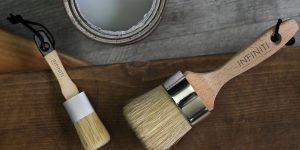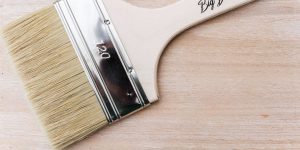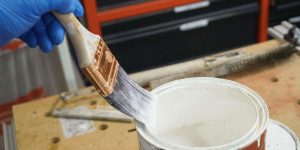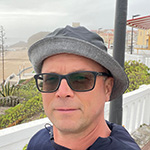The trims around the doors and windows, as well as baseboards, require repainting from time to time to preserve their fresh look. That’s where you might need the best paint brushes for trim. Even though you might think that these tools play an insignificant role in the quality of the final painting work, let me prove the opposite.
When working with narrow and angled areas like the trim, the paintbrush will define how easy it would be to apply paint, how neat and smooth the coverage would be, and more.
If it feels that you are stuck with the choice of the great trim paintbrush, you can put your feet up. I put together this review with top paintbrushes for trimming so you could bother yourself no more with surfing the net and picking decent products on your own.

Paint brushes for trim comparison table
| Name | Size | Material | Brush shape | Review |
|---|---|---|---|---|
| Purdy Clearcut best overall | 2 inch/50 mm | Nylon/polyester | Angled | Review |
| Wooster Silver Tip budget | 2 inch/50 mm | Polyester | Angled | Review |
| Purdy XL Glide large | 3 inch/76 mm | Nylon/polyester | Angled | Review |
| Richard ELEGANCE for small details | 0.75 inch/18 mm | Polyester | Tapered | Review |
| Purdy White Bristle with natural bristles | 2 inch/50 mm | Natural | Straight | Review |
| Wooster Shortcut for baseboards | 2 inch/50 mm | Acrylic | Angled | Review |
How I tested paint brushes for trim
I tested the listed trimming paint brushes on baseboards, door frames, and window trims to check how they would work on various surfaces. I sanded wooden trims to ensure better paint stickiness and make the surface smoother. I also dusted off the surface before brushing it on.
Types of paint brushes for trim
When painting trim, using the right brush is really important. Here are 3 types of brushes that can help you achieve a flawless finish.
- Angled sash brushes: These brushes are your go-to for precision work. With their angled bristles, they’re perfect for getting into tight corners and edging around trim details. Whether it’s the delicate curves of crown molding or the edges of window frames, these brushes allow you to create clean, crisp lines.
- Straight sash brushes: If versatility is what you’re after, straight sash brushes are the way to go. They have flat, straight bristles that work well for both trim and broader surfaces like doors and cabinets. These models offer good coverage and are easier to handle than angled brushes, making them a great all-rounder for your painting projects.
- Stubby brushes: When you need to tackle those hard-to-reach spots or intricate trim, stubby brushes are your secret weapon. With their short handles and bristles, they’re designed for close-up work. Think behind toilets, between radiator fins, or detailed trim work. Their compact size gives you maximum control and maneuverability.
Best paint brush for trim reviews
Purdy Clearcut – best overall

The Purdy Clearcut 2-inch/50 mm brush provides an excellent cutting-in capability with all paint types.
Unlike the Purdy White Bristle brush with natural bristles, this model is made of high-performing Tynex nylon and Orel polyester. Because it’s thick, you can apply more paint with more control. But there is a downside to this – you might notice brush strokes if you fail to distribute the paint carefully. The clear-cut angular bristle shape ensures precise edging.

The Purdy paint brushes feature an ergonomic hardwood handle that is lightweight and moisture-wicking, making them easy to control. The handle also has a hole to hang the brush when the painting job is done.
The Purdy Clearcut has proved to be the best paint brush for trim due to the precision and the ease of paint application.
Key specs
- Size, inch/mm: 2/50.
- Material: Nylon/polyester.
- Brush shape: Angled.
Pros
- Suitable for all paint types.
- The mix of nylon and polyester for enhanced stiffness.
- Angled bristle design for more edging precision.
- Ergonomic hardwood handle.
Cons
- Might leave insignificant brush strokes sometimes.
Wooster Silver Tip – budget

Gain superior control during the paintwork and achieve the smoothest finish with the 2-inch Wooster Silver Tip brush.
Similar to the Purdy Clearcut brush, this tool has an angled brush design. But unlike its more expensive rival with stiff bristles, the Wooster Silver Tip brush is soft. The bristles are made of chemically-tipped polyester, making them thin, flexible, and soft. However, you might find the bristles slightly stiffer than other soft brushes. Also, the brush showed signs of rust after the first use.

The choice of hardwood for the handle is a testament to the brush’s durability. It can withstand the rigors of professional use, including exposure to various paint types and cleaning agents. In addition, the filament holds a fairly large amount of paint, settles it well, and has good leveling properties with all types of paint.
It feels good in the hand. No shedding at all, making it the best paint brush for trim and baseboards in the budget-friendly segment.
Key specs
- Size, inch/mm: 2/50.
- Material: Polyester.
- Brush shape: Angled.
Pros
- No shedding or brush strokes.
- A universal 2-inch size.
- Angled brush shape for better edging.
Cons
- Signs of rust after the first use.
- It might feel stiffer than other soft brushes.
Purdy XL Glide – large

The 3-inch Purdy XL Glide brush will make the refreshing trim job a breeze.
The Purdy XL Glide brush is 1-inch larger than the Purdy Clearcut, making it suitable for larger projects. Due to the mix of DuPont solid, round, tapered Tynex, and Orel filaments, the Purdy XL Glide brush works great for all paint types. The angled design ensures smooth edging and better corner coverage.

The natural wood handle is good, and the brush overall gives a glass-like finish. But you may find that some bristles stick to the wet paint. The brads holding the ferrule might get loose after moderate use, causing the brush head to wobble.
This brush boasts long bristle life, so it’s a great choice if you want to have a larger brush for your refreshing or painting projects.
Key specs
- Size, inch/mm: 3/76.
- Material: Nylon/polyester.
- Brush shape: Angled.
Pros
- 3-inch brush for all paints, even thick ones.
- Stiff enough due to the mix of synthetic materials.
- Long bristle life and great coverage.
Cons
- Seldom bristles fall out.
- The ferrule gets loose over moderate use.
Richard ELEGANCE – for small details

Being made of 100% polyester SRT, this ⅝-inch Richard ELEGANCE is perfect for neat trimming and cutting-in around doors. The tapered end also does its job – painting the corners is easier than ever. It delivers a smooth finish, especially when you use latex paint. But if you do not know how to use this brush the right way, you may find that the paint is hard to control.

In contrast to Purdy Clearcut with a standard wood handle, this product features a soft-grip handle. However, it might feel stiffer in your hands.
All the bristles stayed in their place after the first use. All in all, if you harness the stiff bristles of the Richard ELEGANCE, you’ll end up having a great brush for tiny painting projects.
Key specs
- Size, inch/mm: 0.75/18.
- Material: Polyester.
- Brush shape: Tapered.
Pros
- Compact size (⅝ inch) for covering small details.
- Smooth coverage with latex paint.
- Soft-grip handle for ease of use.
Cons
- It might be hard to control the paint.
- The handle can feel too stiff in your hand.
Purdy White Bristle – with natural bristles

You’ll love the ultra-smooth finish of this Purdy White Bristle Sprig brush for oil-based paints, stains, and clears.
The 2-inch brush has a hardwood Beavertail-style handle, which is pretty convenient. The flat sprig shape of the brush makes it a universal tool for your DIY projects, including refreshing trims or baseboards. In contrast to the synthetic Purdy Clearcut brush, this item boasts natural soft bristles. It gives zero brush strokes and bubbles, but I faced another issue.

This brush loses bristles, which might ruin the painting project.
The Purdy White Bristle Sprig is a cool natural brush for painting trim or baseboards. Its soft bristles leave no strokes and give satisfying painting results.
Key specs
- Size, inch/mm: 2/50.
- Material: Natural.
- Brush shape: Straight.
Pros
- Designed for oil-based paints, stains, and clears.
- Natural soft bristles for a smooth finish.
- Zero brush strokes and bubbles.
Cons
- Bristles fall out from time to time.
Wooster Shortcut – for baseboards

You will enjoy painting baseboards with this Wooster Shortcut brush, suitable for all paints.
Unlike Richard ELEGANCE meant to work out every detail of the object, this 2-inch Wooster Shortcut brush with synthetic bristles will help you get into tight places due to the flexible Shergrip handle. It will also prevent your hands from aching and blistering.

This brush gives you more control when painting a straight swatch due to the angled design. But because it absorbs paint heavily, the bristles are hard to clean. You may also find it streaky.
This Wooster Shortcut professional trim paint brush will let you refresh the baseboards in your place while being easy on your hands.
Key specs
- Size, inch/mm: 2/50.
- Material: Natural.
- Brush shape: Straight.
Pros
- A flexible Shergrip handle for added comfort.
- Synthetic bristles for all paints.
- Angled brush design for straight swatches.
Cons
- Can be streaky sometimes
- Hard to clean due to the bristle texture.
Trim paint brush buying guide

Brush size
The properly chosen paintbrush size is the key to neat paintwork. Before you decide on the paint brush for interior trim, measure the surface you’ll be working with. This will give you a better idea about what size of brush you may need. For instance, a one-inch small paint brush for trim won’t be a great assistant when you’ve got to dye a 20-inch windowsill. However, you may want to get a smaller-sized brush for tight corners or intricate woodwork.
Brush shape
There are different brush shapes that define the tool’s application. A straight, also known as a square, brush is a universal solution, and it is applicable for almost all painting projects. But when you want to obtain better coverage, you may want to consider the rounded or angled bristle shape.
Bristles material
The paint brushes for trim work come with different bristle material options. Natural bristle brushes made of animal hair (white boar, horse, goat) and plants (Tampico) are common choices for shellac, polyurethane finishes, and oil-based paints since they hold more paint and ensure a smooth coverage. Synthetic (nylon, polyester, PVC, polyethylene) brushes are easy to clean, and they keep the bristle shape better than natural bristles. They are mainly used for latex and water-based paints.
Handle shape
Most brushes come with straight handles, both short and long, to allow you to easily trim and edge baseboards, window, and door trim. You can also come across angled handles for precise cut-ins or flexible handles, which adjust to any angle.
Factors to consider when choosing a paint brush
A great paint brush for doors and trim can turn a daunting task into a breeze, leaving your trim looking flawless. Here are some key factors to consider when selecting the ideal brush for your trim project:
Trim material
First things first, take a look at your trim material. Is it wood or metal? If you’re dealing with wood trim, opt for a brush with soft bristles like natural bristle brushes. They’re excellent at absorbing paint into the wood’s texture, ensuring even coverage and a smooth finish. On the other hand, if you have metal trim, synthetic brushes are your best friend. They resist moisture and are less prone to rust or corrosion, making them ideal for metal surfaces.
Paint type
The type of paint you’re using also plays a significant role in the paintbrush selection. For latex paints, which are water-based and commonly used for decorative purposes, go for synthetic brushes. They don’t soak up water and maintain their shape during use. For oil-based paints or enamels, natural bristle brushes are your go-to choice. These models hold more paint and provide a smoother application. Plus, they’re easier to clean with mineral spirits.
Project complexity
Consider the complexity of your painting project. If you’re tackling intricate trim or detailed crown molding, you’ll need a brush with fine bristles and excellent control to ensure precision. But if you’re working on a simpler, cleaner-cut project, a more general-purpose brush will do the trick just fine.
How to paint interior trim?

Painting interior trim can completely transform the look of your space. To get started, make sure you’ve properly prepared the trim by cleaning it and filling any gaps or holes. Sand the surface lightly to ensure it’s smooth.
Next, choose a high-quality trim paint that suits your style and complements your room’s decor. For the actual painting, using a high-quality brush, like the Wooster Silver Tip, is essential. It provides precise control, allowing you to work in small sections, starting at one end and progressing to the other.
Apply the paint in even strokes, using long, continuous motions, and feather the edges to blend the paint seamlessly. After the first coat, let it dry completely before deciding if you need a second coat for a flawless finish.
Find more trim painting tips in this article.
How to avoid brush strokes when painting trim?
Preventing brush strokes on your trim is crucial for a professional finish. Start by selecting the right brush, one specifically designed for trim work, such as the Wooster Silver Tip, with finely flagged bristles for a smooth result. Consider thinning your paint slightly to improve its flow and reduce the chances of brush marks. When spreading the paint, work quickly and avoid overworking it. Apply the paint in one direction and refrain from going back over areas that have started to dry.
Proper technique is key; feather your brush strokes at the edges of each section to seamlessly blend them. Additionally, lightly sand the trim between coats to eliminate imperfections and create a smooth surface for the next layer.
What should I use to paint trim: brush or roller?
When it comes to painting trim, a brush is typically the better choice. It provides precise control, allowing you to navigate corners, edges, and intricate details with ease. A high-quality brush can deliver a smooth finish with minimal brush strokes. While rollers excel at covering large, flat surfaces like walls, they may lack the precision required for trim work. However, for exceptionally large trim or trim with minimal detailing, a small foam roller can be a suitable alternative. Always choose the tool that ideally suits the specific requirements of your trim and provides the finest results for your project.
FAQ
What size brush should I use to paint trim?
When painting trims either inside or outside, it is important to match the width of the brush to the size of the surface being painted. The best way to figure out what size brush to use is to measure the width of the surface being painted.
For example, a 1″ brush should be used for painting door and window frames that are approximately 1″ wide.














